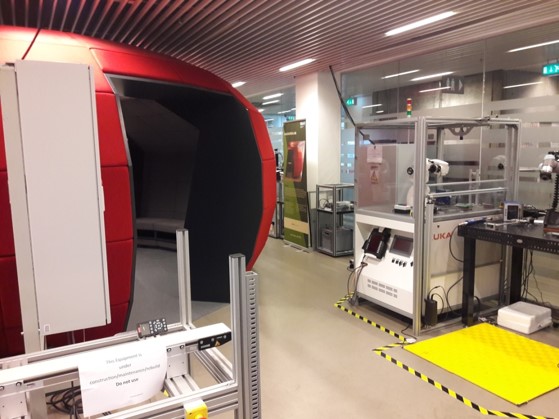Smart Factory Lab
Table of contents
The Smart Factory (SF) Lab supports research and teaching at the section Technology Entrepreneurship and Innovation (TEI) at SDU. The laboratory is targeting physical implementation of simulations and is as such designed to support Digital Twins.
The activities in the lab include building production systems, as part of the course Production Technologies (P-TECH), as well as research in Matrix-Structured Manufacturing Systems. The lab supports the design of automation systems for modular machines. The current setup includes 5 modules that cover all aspects of the machine, including mechanical structures, electrical systems and automation. A virtual model already exists for such modules, and it can potentially be considered a Digital Twin if bidirectional communication is enabled. Although the machines can be operated remotely, this is currently not allowed due to safety requirements, and the scope of the project itself. This feature can be enabled in case the physical lab is directly linked to the virtual model, and has restricted access.
The lab also includes a small workshop area for light assembly and minor processing of production equipment.
The teaching activities carried out in the Smart Factory Lab require the physical attendance of students. The learning objectives of the P-TECH course include the ability to analyse and solve problems posed by real-life situations in the field of automation development. At the current state it is necessary for students to physically operate in the lab. A future development could include a detailed representation of the physical components to allow students to operate them virtually, with the aid of Virtual Reality.

Smart Factory Lab
Lab Assets
The Smart Factory Lab is currently used for research and educational purposes. To support these activities, the laboratory consists of three main areas, and is equipped with relevant assets.
| Name | Description |
|---|---|
| KUKA KR3 R540 | KUKA Ready2Educate Advanced Vision |
| UR5e | Collaborative Robot |
| Siemens PLCs (ET200SP, S7- 1500, S7-1200) | PLC |
| B&R PLC (X20CP1686) | PLC |
| Matrix Production Cell | Contains:KUKA robot
|
| Unimat Lathe | Small educational CNC lathe on custom transport carrier |
| Unimat Mill | Small educational CNC mill on custom transport carrier |
| 3 gravity conveyors | For teaching purposes (P- TECH) |
| 2 belt conveyors | For teaching purposes (P- TECH) |
| 2 3D printers | Unimat + FlashForge Inventor |
XR Software tool: Unity.
Simulation Software tools: Siemens Tecnomatix Plant Simulation, Visual Components, Siemens NX Mechatronics Concept Designer, Anylogistix, Siemens Tecnomatix Process Simulate.
Virtual Lab
The complete data formalization of the virtual lab can be found in: https://virladee.github.io/repo/spreadsheets/SmartFactory.xlsx
The Smart Factory virtual lab can be freely accessed online.

Smart Factory lab visualized with VEB.js
Lab Access
Both researchers and students at the Engineering, Innovation & Business study program can get access to support their activities. Student access is granted in close dialogue with the lab manager, supervisor, and head of section to ensure all safety measures are being followed. The same rules apply for external stakeholders in regard to access to the lab.
The access to the virtual smart factory lab is open in its current configuration. Further data, not included in this model, can be made accessible to relevant stakeholders if needed.
Lab Activities
Repurposing used lab equipment and machines constitutes one of the goals at the SF lab. The Virtual Lab supports researchers in this activity. One of the possible uses of the virtual lab includes discrete-event simulation, to support layout reconfiguration or the repurpose of modular machines. Testing new scenarios virtually avoids the need to move the machinery, which constitutes a difficulty. The purpose of this use is prediction, and its main value is time-saving and risk reduction. On the other hand, the operation of the
machines is valuable on the physical lab, but not justified in the virtual counterpart, for the time being. The use of the virtual lab for testing purposes is only enabled by detailed models of the mechanical systems, electrical diagrams and PLC programs for each of the machines. For these reasons, at the time being, the testing of the machines is only done physically.
The model of the Smart Factory Lab shows a real potential for the use in teaching activities, in the case of a pandemic or in general when remote access is required. The current state of the Virtual lab allows Digital Shadow implementation, as shown by past experiments. The remote use of the physical Smart Factory Lab currently does not justify the risks associated with it. Safety issues arise when operating experimental machines remotely, and this is not in the scope of project. Nevertheless, in case of accessibility restrictions (e.g. a pandemic), the development of a Digital Shadow, or even a Digital Twin, is possible. At the current state the Virtual Lab exists (also) as a 3D model of the real one, with a certain level of accuracy, and can be explored through on-screen or world-space menus.
The potential for the virtual use of the Smart Factory Lab is enhanced by the combination of the lab with the VR Lab and Simulation Lab. Past experiments showed in fact that the equipment stored in the Smart Factory Lab can be accessed through its digital model, and one-way interaction is possible. This was verified in the context of the matrix production cell, which could be controlled remotely from a 3D environment. This represented the case of a Digital Shadow, with the physical asset under control of the virtual counterpart.
Research for the implementation of a Digital Twin is currently undergoing. A set of conveyor belts in the Smart Factory Lab is equipped with sensors (e.g. force, speed, temperature etc.) which provide data to a server, where a machine learning algorithm collects it and processes it for the scope of predictive maintenance. Visual Components and Unity have been used to develop the 3D model, whereas Azure hosts the data collected.